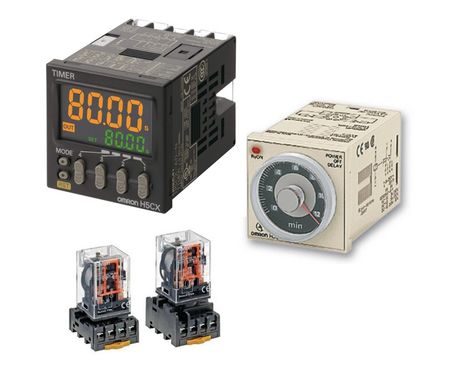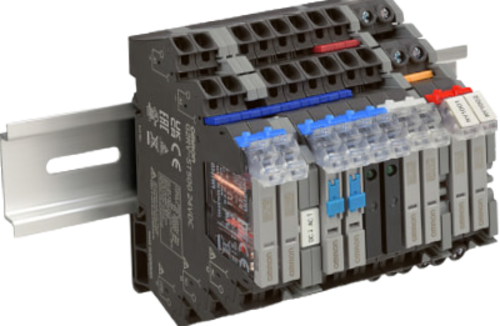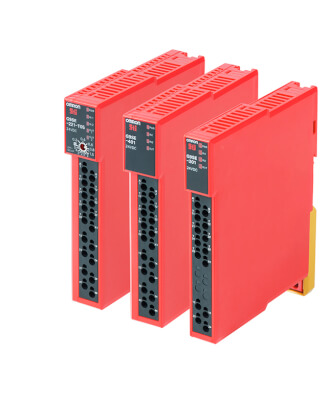Omron Timers and Relays
61F-GP-N 110VAC - Omron relay
art. G3PW1003R
Omron power controller G3 series
- G2RV compatible
- Built-in SSR LED indicator
- Push-in Plus technology and accessories for easy connection
art. G6B41037M - Omron PCB
GP Power Relay Socket
art. G6D41006H
GP Power Relay Socket
Compact safety relays - Omron g9se
art. G9SE9004G
G9SE series
art. AA041676H
G9SR Series
art. H3CA3064A
H3CA series
Omron H3CR Timer
Omron h3 cr
art. H3CR8022M
Omron Timer h3cr - H3CR series
art. H3CR8020C
H3CR series
Omron Timer Relay h3y 2
art. H3Y 6001C - Timer Relay Omron h3y 2
H3Y series
art. H3Y 6004H
H3Y series
art. H3Y 6073M
Omron Timer relay H3Y 2 - H3Y series
art. H3Y 6126E
H3Y series
art. H3Y 6124R
H3Y series
art. H5CX6012R
H5C series
art. H5CX6014E
Omron timer h5cx - H5C series
art. H7CC7009B
H7C series
art. H7CX6006M
Counter h7cx Omron - H7C series
art. H7CX6013C
Omron Counter H7CX - H7C series
art. H7CX7024D
Omron Time Counter H7C series
Omron K8AB PM2
In the realm of industrial automation, Omron relays and timers are pivotal components that enhance the efficiency, precision, and reliability of automated systems. These devices, while often working behind the scenes, are essential for the smooth operation of complex processes.
In the simplest terms, timers are devices that control the duration of time that a particular process or event takes. In industrial automation, timers are used to manage the timing of operations, ensuring that processes start, stop, or change state at precisely the right moment. This timing control is essential for synchronizing various components of an automated system, ensuring that everything operates smoothly and efficiently.
The main characteristics of Omron timers
1. Timer type
Omron offers a wide range of timers to suit a variety of needs, including:
- On-delay: This type of timer delays the on-off of the output for a specified time after a signal is applied to the input.
- Off Delay: This type of timer delays the output from turning off for a specified time after the input signal is removed.
- Interval Timer: This type of timer turns the output on and off at set time intervals.
- Loop Timer: This type of timer turns an output on and off in a repeating sequence with specified on and off times.
2. Time range: The time range of Omron timers can vary from milliseconds to hours, depending on the model.
3. Supply voltage: Omron timers are available with a variety of supply voltages including 24VDC, 110-220VAC.
4. Output type
Omron timers can have relay output, transistor output or open collector output.
- Relay output: This type of output uses a relay to control an electrical circuit.
- Transistor Output: This type of output uses a transistor to control an electrical circuit.
- Open Collector Output: This type of output uses an open collector transistor to drive the electrical circuit.
Functions of Omron timers
Omron timers offer a wide range of features that make them ideal for a variety of industrial applications. Some of the more common features include:
1. Programming:Some Omron timers can be programmed to run complex time sequences. This can be useful for applications where multiple events need to be handled at a given time. For example, a timer can be programmed to turn on the pump, run it for a certain amount of time, and then turn it off.
2. Cascade connection:Some Omron timers can be cascaded together to create more complex time management systems. This can be useful for applications where multiple timers need to be controlled synchronously. For example, timers can be cascaded to control the sequence of steps in a manufacturing process.
3. Manual or remote reset:Some Omron timers can be manually or remotely reset. This can be useful for applications where you need to reset the timer without stopping the power supply. For example, the timer can be manually reset to stop the process if a problem occurs.
4. Status display:Some Omron timers have status indicators that show the output status. This can be useful for debugging and troubleshooting. For example, a status indicator can show whether a timer output is enabled.
5. Overvoltage protection:Some Omron timers have surge protection to protect against damage. This can be useful for applications where the timer may be affected by overvoltage.
6. Other functions:
Omron timers may also have other functions such as:
- Switch-on delay: This function delays the switching on of the output for a specified time after the signal is applied to the input.
- Off Delay: This function delays the output off for a specified time after the input signal is removed.
- Interval Timer: This feature turns the output on and off at set time intervals.
- Loop Timer: This feature turns the output on and off in a repeating sequence with preset on and off times.
- Open Collector Output: This type of output uses an open collector transistor to drive the electrical circuit.
- Relay output: This type of output uses a relay to control an electrical circuit.
- Transistor Output: This type of output uses a transistor to control an electrical circuit.
Types of Omron timers
Omron offers a wide range of timers to meet the different needs of industrial applications. Some of the more common types of timers include:
1. Switch-on delay timers: These timers delay the activation of the output for a specified time after the signal is applied to the input. They are widely used to control the running time of electrical devices such as motors, heaters and lighting.
2. Off delay timers: These timers delay the output from turning off for a specified time after the input signal is removed. They are widely used to prevent sudden shutdown of devices, which can cause damage or loss of data.
3. Interval timers: These timers turn the output on and off at set time intervals. They are widely used to control cyclic processes such as coolant supply or paint spraying.
4. Cyclic timers: These timers turn an output on and off in a repeating sequence with set on and off times. They are widely used to control complex processes such as production lines or irrigation.
5. Multifunctional timers: These timers offer a combination of on-delay, off-delay, interval, and loop timer functions. They provide maximum flexibility for different applications.
6. Programmable timers: These timers allow the user to create complex time sequences using software. They are ideal for applications where precise timing is required or where time sequences may vary.
7. Timers with relay output: These timers have a relay output that can be used to control high current electrical devices.
8. Timers with transistor output: These timers have a transistor output that can be used to control lower current electrical devices.
9. Timers with open collector output: These timers have an open collector output that can be used to control electrical devices with different supply voltages.
10. Compact timers: These timers are small in size, making them ideal for use in confined spaces.
11. Timers for installation on the panel: These timers are designed for mounting on control panels or cabinets.
12. Waterproof timers: These timers are designed for use in humid or dusty environments.
Popular models in the Omron timer line
Omron offers a wide range of timers to meet the different needs of industrial applications. Some of the most popular models include:
- Omron e5jc: This series of on/off delay timers offers a wide range of features including programming, cascading and manual or remote reset. Its compact size and affordable price make it a popular choice for general applications.
- Omron e5cn: This series of multi-function timers offers a wide range of features including programming, cascading, manual or remote reset, status indication and overvoltage protection. Its reliability and flexibility make it a popular choice for demanding applications.
- Omron h3cr: This series of compact on/off delay timers offers an easy-to-use interface and an affordable price. Its compact size makes it a popular choice for limited spaces.
- Omron h3cn: This series of multi-function timers offers a wide range of features including programming, cascading, manual or remote reset, status indication and overvoltage protection. Its compact size and flexibility make it a popular choice for complex applications in limited spaces.
- Omron k8sc: This series of high-performance timers offers a wide range of features including programming, cascading, manual or remote reset, status indication and overvoltage protection. Its high accuracy and reliability make it a popular choice for critical applications.
Omron Relays
Relays are fundamental switching devices that control circuits through an electromagnetically operated switch. They allow a low-power signal to control a high-power circuit, providing electrical isolation and safeguarding sensitive components from high-voltage spikes. Omron relays are particularly renowned for their robustness and versatility, catering to a broad spectrum of industrial needs.
Main characteristics of Omron relays
- Contact Type: Omron offers relays with a variety of contact types, including normally open (NO), normally closed (NC), and changeover (C).
- Number of contacts: Omron relays are available with different numbers of contacts, from one to several dozen.
- Voltage and Current Ratings: Omron relays are available with different voltage and current ratings to suit different needs.
- Coil Type: Omron offers relays with a variety of coil types including direct current (DC), alternating current (AC) and light sensitive.
- Form factor: Omron relays are available in a variety of form factors, including compact, standard, and modular.
- Functions: Omron relays can have various functions such as sealing, status indication and overvoltage protection.
Types of Omron relays
Omron offers a wide range of relays to meet the different needs of industrial applications. Some of the more common types of relays include:
1. Time relay: These relays turn the output on or off after a certain time after a signal is applied to the input. They are widely used to control the delay or sequence of events in automation systems.
2. Photo relay: These relays respond to changes in light intensity. They are widely used for lighting control, object detection, and other applications where sensitivity to light is required.
3. Omron current relay: These relays respond to changes in current in an electrical circuit. They are widely used for equipment protection against overloads, fault detection and other applications where current sensitivity is required.
4. Voltage relay: These relays respond to voltage changes in the electrical circuit. They are widely used for equipment surge protection, fault detection, and other applications where voltage sensitivity is required.
5. Solid-state relays: These relays use semiconductor components to control an electrical circuit. They offer quiet operation, high switching speed and long life compared to electromechanical relays.
6. Electromechanical relays: These relays use an electromagnet to control an electrical circuit. They are more affordable than Omron solid state relay and offer a simple design.
7. Omron general purpose relay: These relays are suitable for a wide range of applications. They have a simple design and are affordable.
8. Relay for printed circuit boards: These relays are designed for mounting on printed circuit boards. They have a compact size and are suitable for use in limited space.
9. Relay vacuum: These relays are vacuum sealed, making them resistant to dust, dirt and vibration. They are suitable for use in harsh environments.
10. Relay for explosive environments: These relays are certified for use in potentially explosive atmospheres. They are specially designed to prevent a spark that could cause an explosion.
Popular Omron relay models
Since Omron offers a wide range of relays for different applications, it is difficult to identify the most popular models.
However, some of the commonly used and highly rated Omron relay models include:
1. Omron g5rl:
- General purpose electromechanical relays
- Available in a wide range of pin configurations (SPST, SPDT, DPDT)
- Rated current up to 20 A
- Compact size
- Available with different coil types (DC, AC)
- Suitable for a wide range of applications such as motor switching, lighting and signaling.
2. Omron G4RN:
- omron solid state
- Silent operation
- High switching speed
- Long service life
- Available in a wide range of pin configurations (SPST, SPDT, DPDT)
- Rated current up to 30 A
- Suitable for applications where quiet operation, high switching speed or long service life are required, such as CNC machine tools and medical equipment.
3. Omron my3n:
- Omron time relay
- A wide range of time delays from 0.01 s to 180 minutes
- Available in on-delay, off-delay, interval and cycle timer modes
- One or two exits
- Rated current up to 10 A
- Suitable for delay control or sequence of events in automation systems.
4. Omron g3dz:
- Photo relay
- Different detection ranges
- Available in DC and AC types
- Open collector or NPN output
- Compact size
- Suitable for object detection, liquid level control and other applications where sensitivity to light is required.
5. Omron g2rl:
- Electromechanical relays for printed circuit boards
- Compact size
- Available in a wide range of pin configurations (SPST, SPDT, DPDT)
- Rated current up to 10 A
- Suitable for applications in limited space, such as printed circuit boards and control panels.
Omron timers and relays are essential components in the field of industrial automation, known for their reliability, precision, and versatility. Whether you need to control high-power circuits or manage precise timing operations, Omron’s products are designed to meet these critical needs. Their robust construction, advanced features, and user-friendly design make them a valuable addition to any automation setup.
For a large selection of omron timers catalogue and relays, visit the Eltra-Trade website. Our experienced managers are always ready to help you choose the right products and provide expert advice to ensure your production processes are optimized for efficiency and reliability.



